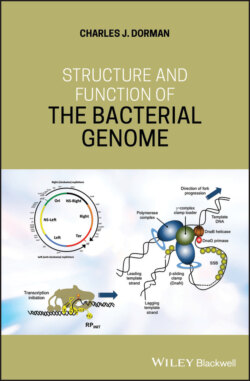Читать книгу Structure and Function of the Bacterial Genome - Charles J. Dorman - Страница 57
1.46 A Truncated H‐NS‐Like Protein
ОглавлениеThe serU island in UPEC that encodes H‐NSB/Hfp also encodes a protein that resembles a truncated H‐NS. This is H‐NST and its gene is tightly linked to the hnsB gene in the chromosomal island. H‐NST consists of the first 80 amino acids of H‐NS and the corresponding island in EPEC encodes a closely related protein; EAEC also encodes a relative of H‐NST (Williams and Free 2005). H‐NST from UPEC can form a heterodimer with H‐NS and it can antagonise its activity as a transcription silencer. The corresponding protein from EPEC is much attenuated in its ability to interact with H‐NS and to attenuate its biological activity: a key substitution at residue 16 of the amino acid sequence seems to be responsible for this difference between the UPEC and EPEC H‐NSTs (Williams and Free 2005).
The action of H‐NST recalls that of the gene 5.5 protein that is encoded by bacteriophage T7. Like H‐NST, the gene 5.5 protein co‐purifies with H‐NS and antagonises the transcription silencing activity of H‐NS, presumably to the benefit of the phage (Liu and Richardson 1993). H‐NST and the gene 5.5 protein resemble one another in size and mode of action structure but not in amino acid sequence (Williams and Free 2005). The ability of H‐NST from EPEC to inhibit H‐NS activity has been exploited to explore the H‐NS− phenotype of Yersinia enterocolitica, a bacterium where H‐NS is essential (Baños et al. 2008). The essential nature of H‐NS in Y. enterocolitica probably reflects the absence of a paralogous protein such as StpA that can offset the severe phenotype associated with the loss of H‐NS. Expressing EPEC H‐NST ectopically in Y. enterocolitica titrates the transcription silencing of H‐NS, revealing that it has similar effects on global gene expression patterns to those seen in other Gram‐negative bacteria such as E. coli (Baños et al. 2008).
